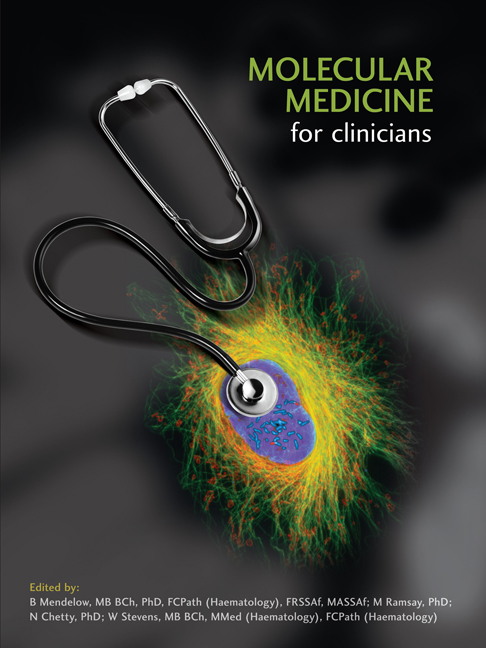Book contents
- Frontmatter
- Contents
- Foreword
- Acknowledgements
- Chapter 1 Introduction
- Keynote Essay 1: Defining Who We Are: DNA in Forensics, Genealogy and Human Origins
- Section 1 Principles Of Cellular And Molecular Biology
- Chapter 2 Digital Concepts in Molecular Medicine
- Chapter 3 The Anatomy and Physiology of the Genome
- Chapter 4 Molecular Cell Biology
- Chapter 5 Genetic Variation
- Chapter 6 Genes in Development
- Chapter 7 Tools of Molecular Medicine
- Chapter 7a Nucleic Acid Methods
- Chapter 7b Protein Methods
- Chapter 7c Cellular Phenotyping and Flow Cytometry
- Chapter 7d Molecular Cytogenetics
- Keynote Essay 2: The Human Genome
- SECTION 2 MOLECULAR PATHOLOGY
- SECTION 3 MOLECULAR THERAPEUTICS
- SECTION 4 RESEARCH AND THE CONTINUING EVOLUTION OF MOLECULAR MEDICINE
- Glossary
- Contributors’ Biographies
- Source Material And Recommended Reading
- Permissions And Credits
- Index
Chapter 7c - Cellular Phenotyping and Flow Cytometry
from Chapter 7 - Tools of Molecular Medicine
Published online by Cambridge University Press: 04 June 2019
- Frontmatter
- Contents
- Foreword
- Acknowledgements
- Chapter 1 Introduction
- Keynote Essay 1: Defining Who We Are: DNA in Forensics, Genealogy and Human Origins
- Section 1 Principles Of Cellular And Molecular Biology
- Chapter 2 Digital Concepts in Molecular Medicine
- Chapter 3 The Anatomy and Physiology of the Genome
- Chapter 4 Molecular Cell Biology
- Chapter 5 Genetic Variation
- Chapter 6 Genes in Development
- Chapter 7 Tools of Molecular Medicine
- Chapter 7a Nucleic Acid Methods
- Chapter 7b Protein Methods
- Chapter 7c Cellular Phenotyping and Flow Cytometry
- Chapter 7d Molecular Cytogenetics
- Keynote Essay 2: The Human Genome
- SECTION 2 MOLECULAR PATHOLOGY
- SECTION 3 MOLECULAR THERAPEUTICS
- SECTION 4 RESEARCH AND THE CONTINUING EVOLUTION OF MOLECULAR MEDICINE
- Glossary
- Contributors’ Biographies
- Source Material And Recommended Reading
- Permissions And Credits
- Index
Summary
INTRODUCTION
A blood film prepared on a glass slide and stained with a coloured dye can be viewed under a microscope as in Figure 1. The microscope uses a light source to illuminate the slide to visualise many of the cellular components in blood such as red and white blood cells and platelets. Through the objectives the cellular components of blood are magnified and detail of the blood cells can be determined. This is the basis for histochemistry and is still widely used today. The technique called flow cytometry is in a sense the big brother to micro - scopy visualisation of blood. The light source in a flow cytometer is a laser that is more power ful than a microscope's light globe and the objectives are replaced by very sensitive light (photon) detectors, filters and mirrors. Flow cytometry is the study of cells (cytometry) like microscopy but in suspension (flow), and can investigate many more parameters of the cells all at once. In fact a flow cytometer can analyse more than 1000 events per second and store five and more parameters per event at one time.
This speed and increased information makes the flow cytometry technology attractive for research and pathology labora - tory services. Several scientific advances (fluor escent protein labelling in the 1940s; hybridoma cell fusion for monoclonal antibody reagent production in the 1980s; the development of cytofluorometer instru - men tation in the 1950s; and the design of air-cooled lasers combined with advanced, user-friendly software for personal computers in the 1960s) have made this technology available as ‘bench-top’ instruments.
A further very important advance is the organisation of the CD (clusters of differen - tiation) antigens. Several research laboratories the world over were producing monoclonal antibodies against different antigen epitopes on cell membranes and intracellular proteins.
Monoclonal antibodies are monovalent (to a single epitope) antibodies generated by an immortal hybridoma cell in tissue culture. The hybridoma cell is a fusion partner established and maintained in tissue culture between a plasma B cell and a myeloma cell. This partnership ensures continual secretion of antibodies all with the same antigen binding recognition site. Each monoclonal antibody that was manufactured had a unique name, which made comparative research on the same antigen very difficult.
- Type
- Chapter
- Information
- Molecular Medicine for Clinicians , pp. 95 - 101Publisher: Wits University PressPrint publication year: 2008

